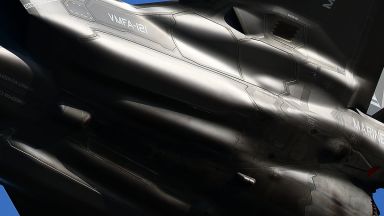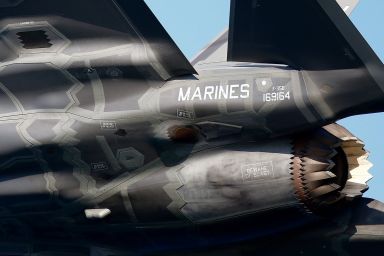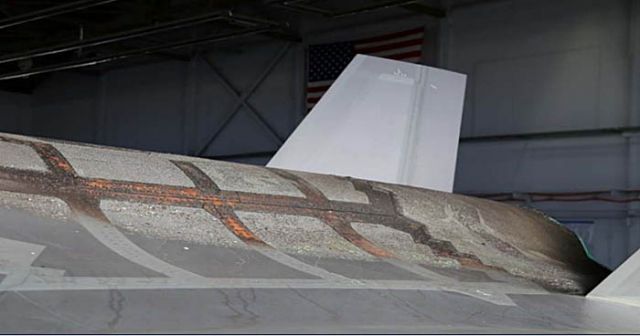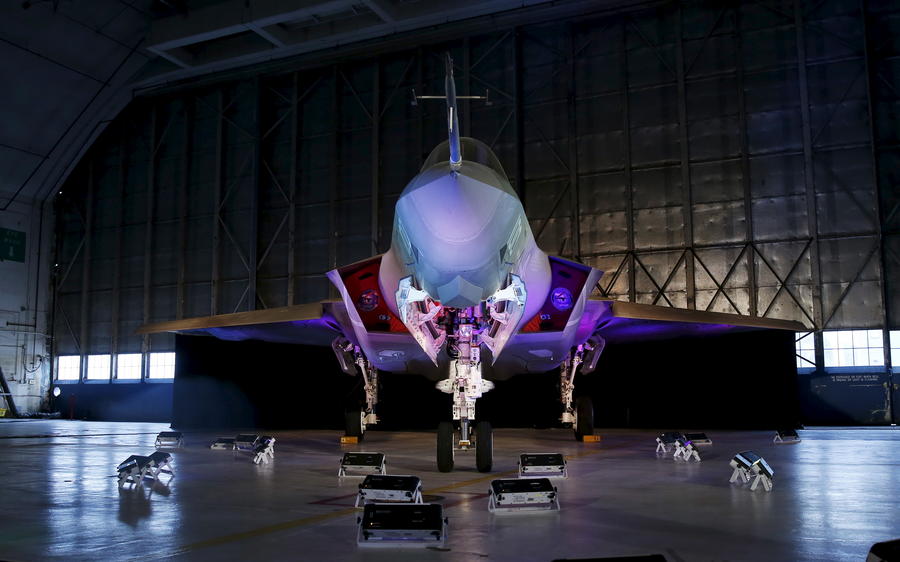-
![[image]](https://www.balancer.ru/cache/sites/f/a/farm4.staticflickr.com/3701/128x128-crop/8975925628_787591e41e_o.jpg)
F-35 Новости
Теги:
s.P.> Пуск с отрицательной перегрузкой.
вообще говоря, перегрузки тут нет. Траектория прямолинейная
Просто пуск вверх ногами.
А что по всяким вконтактегам бредят школяры - дык они и не такого раскажут)
вообще говоря, перегрузки тут нет. Траектория прямолинейная

Просто пуск вверх ногами.
А что по всяким вконтактегам бредят школяры - дык они и не такого раскажут)



Завершены переговоры о приобретении ЦАХАЛом семнадцати самолетов F-35
В минувшие выходные делегация министерства обороны завершила переговоры о приобретении в США 17 самолетов F-35, сообщили из пресс-службы оборонного ведомства. // www.newsru.co.il

Will The U.S. Retrofit Older F-35s To Fight Or Buy New?
Вкратце суть новости: апгрейдить старые Ф-35 или купить новые?
После принятия на вооружение в самолёте было произведено 150-160 модификаций которые привели к нынешней версии Block 3F. И теперь они решают этих отмыть или новых нарожать?
Есть впечатление, что старые сплавят "союзникам" низшего звена с какой-нибудь скидкой, а то и без вообще, если получится.
NATIONAL HARBOR, Maryland—Faced with a set of F-35 Joint Strike Fighters that are too limited to fly in combat, the U.S. military is faced with the question of what to do with them—upgrade or buy new?
The F-35 Joint Program Office is on the cusp of a major increase in F-35 production of F-35s. In 2016, Lockheed Martin delivered 46 of the fighters. By the end of 2018, the company should be producing 130 per year, according to Vice Adm. Mat Winter, the head of the program. And the rate of production will increase even further.
At the same time, the program is juggling multiple configurations of the aircraft—not just because there are Air Force, Marine Corps and Navy variants, but also because production began before flight tests were finished. That issue, known as concurrency, continues to bedevil the military’s ability to afford the program, as it will take a lot of work to bring some of the oldest F-35s up to the standard they will need to fight in combat.
“From a production perspective, we have literally 150 to 160 modifications that have to occur on some of our tails to get it to a Block 3 configuration,” Winter said during a Sept. 18 speech at the Air Force Association’s annual Air, Space and Cyber conference here. “Our mods program is almost as exciting and dwarfing our production program.”
With that in mind, Winter said it is time to consider perhaps not modifying every aircraft to the Block 3F standard that would enable it carry a full complement of air-to-air and air-to-ground weapons. Testing of Block 3F could be delivered by the end of this year. “We’re looking at a solution space that gives our warfighter options,” he said.
For the Air Force, some of those options would be whether to use this handful of older F-35s as aggressor aircraft or in other training roles.
Air Force Chief of Staff David Goldfein said there is an ongoing discussion among the Air Force, the other Joint Chiefs and international air chiefs about whether to modify those older F-35s.
“You’re going to see us continuing to do a business-case analysis of retrofit of these aircraft,” he said during a Sept. 19 press conference. But he quickly added that this is not a new kind of discussion—the Air Force had the same one around the F-16, the F-15 and F-22.
Вкратце суть новости: апгрейдить старые Ф-35 или купить новые?
После принятия на вооружение в самолёте было произведено 150-160 модификаций которые привели к нынешней версии Block 3F. И теперь они решают этих отмыть или новых нарожать?
Есть впечатление, что старые сплавят "союзникам" низшего звена с какой-нибудь скидкой, а то и без вообще, если получится.


Фотки деталей на брюшке
Прикреплённые файлы:



Secret F-35, P-8, C-130 data stolen in Australian defence contractor hack | ZDNet
Around 30 gigabytes of ITAR-restricted aerospace and commercial data was exfiltrated by an unknown malicious actor during the months-long 'Alf's Mystery Happy Fun Time' attack. // www.zdnet.comУвели у Австралийцев кучу секретных данных касательно F-35 в том числе.



Авианосец "Карл Винсон" впервые принял на борт истребитель F-35
На борт американского авианосца "Карл Винсон" впервые произвел посадку истребитель пятого поколения F-35C. Тренировки прошли у побережья Южной Калифорнии. // flot.com

Думал в этой теме обсуждали, но что-то не вижу. Что там в реальности произошло, есть данные? А то некоторые прозрачно намекают что "птица" была похожа на ЗУР:

Странно что такие серьезные повреждения, или нет? Или просто фейк? В боевые повреждения лично мне поверить сложно. Хотя всякое бывает... Но фото после столкновения увидеть бы интересно.

СМИ: истребитель F35 выведен из строя после столкновения с птицей
Телеканал "Кан 11" сообщил, что один из новых истребителей F35 вышел из строя после столкновения с птицей во время учебного полета. По информации телеканала, ЧП произошло две недели назад. Пилоту удалось посадить самолет в штатном режиме. В результате инцидента не было пострадавших. // newsru.co.ilСтранно что такие серьезные повреждения, или нет? Или просто фейк? В боевые повреждения лично мне поверить сложно. Хотя всякое бывает... Но фото после столкновения увидеть бы интересно.


Это сообщение редактировалось 22.10.2017 в 08:27
Sergofan> Думал в этой теме обсуждали, но что-то не вижу. Что там в реальности произошло, есть данные?
говорят, пара аистов, что повреждения минимальны, только проверят на станции ТО, в частности, не повреждено ли малозаметное покрытие.
говорят, пара аистов, что повреждения минимальны, только проверят на станции ТО, в частности, не повреждено ли малозаметное покрытие.



В попу надуло - 3
В продолжении прошлогодней истории В попу надуло : ВВС США завершили расследование пожара двигателя на F-35A в прошлом сентябре на авиабазе Маунт-Хоум в Айдахо, вызванного сильным ветром. Верхняя часть хвостовой секции фюзеляжа после пожара Порывы ветра со скоростью до 55 км/ч, дувшие в сопло… // afirsov.livejournal.comВВС США завершили расследование пожара двигателя на F–35A в прошлом сентябре на авиабазе Маунт–Хоум в Айдахо, вызванного сильным ветром.
Порывы ветра со скоростью до 55 км/ч, дувшие в сопло двигателя F135 во время его запуска, вызывали заброс горячего воздуха в воздухозаборник ВСУ (он в трех метрах от сопла, всего). По мере роста температуры на входе в ВСУ последовал ряд отказов, из–за более низкой плотности потока на входе турбина двигателя не добрала оборотов, в результате чего в двигателе стало скапливаться топливо, подача которого все возрастала. В конце концов (секунд через 40) это привело к выбросу горящего топлива из сопла двигателя. Ветер, дующий в хвост, быстро распространил горящее топливо по самолету, вызвав значительные повреждения в его хвостовой части (много чему досталось, шасси, например, "коптилось" 20 секунд). Огонь, охвативший сопло, повредил несколько его секций.
Верхняя часть хвостовой секции фюзеляжа после пожара
Пилот покинул самолет так быстро, что не успел выключить двигатель, получив "незначительные травмы": ожоги головы, шеи, лица и ушей (ничего себе, "незначительные" — процентов 10 ожог тела). Самолет, похоже, таки горел от носа до хвоста. Общий убыток еще не определен, но предварительно оценивается в 17 млн долл (то есть двигателю — хорёк).
Фюзеляж снизу
В подготовленном докладе отмечается, что пилот не был подготовлен для процедуры запуска двигателя при сильном попутном ветре. В летной инструкции отмечается, что при сильном попутном ветре может произойти отказ ВСУ, но предел скорости ветра не определен. Полностью автоматизированный процесс запуска двигателя позволял пилоту надеяться на прохождении процедуры без его участия, тем более, что по утверждению пилота никакого предупреждения о неполадках в бортовых системах не поступало. Если бы пилот перед покиданием самолета выключил двигатель, убыток был бы значительно меньше...
Последствия пожара в отсеке вооружения
Однако уже третий F-35 "сгорел на работе".


http://www.baesystems.com/en/article/f-35a-lightning-ii-airframe-completes-third-life-testing-in-unique-facility
Успешно прошли ресурсные испытания планера F-35A, в которых его подвергали структурным нагрузкам, характерным для полета. Испытывался 3-й жизненный цикл, что эквивалентно 24000 часов "в воздухе" (требования по программе 8000, уже было до этого испытано 2 цикла, т.е. 16000 часов). Данные, полученные в ходе этого цикла испытаний, позволят поддерживать флот F-35 после 2050г. Фото установки (350 тонн, 2500 датчиков напряжения, 160 нагружающих приводов):
Успешно прошли ресурсные испытания планера F-35A, в которых его подвергали структурным нагрузкам, характерным для полета. Испытывался 3-й жизненный цикл, что эквивалентно 24000 часов "в воздухе" (требования по программе 8000, уже было до этого испытано 2 цикла, т.е. 16000 часов). Данные, полученные в ходе этого цикла испытаний, позволят поддерживать флот F-35 после 2050г. Фото установки (350 тонн, 2500 датчиков напряжения, 160 нагружающих приводов):


F-35 Official Arrival at Ørland Air Base
On Nov. 10, 2017, Norwegian government, military and industry leaders celebrated the arrival of Norway’s first three F-35A Lighting II aircraft in a ceremony at Ørland Air Base. The F-35 provides a transformational solution for Norway’s sovereign defense and will serve as a critical element of the Royal Norwegian Air Force for decades to come.


RT на русском
Guest
гость
Сообщение было перенесено из темы Дайджест от января 2018г.
Госдеп одобрил планы по поставкам Бельгии 34 F-35
// Госдеп одобрил планы по поставкам Бельгии 34 самолётов F-35
- VAS [20.01.2018 22:33]: Перенос сообщений из Дайджест от января 2018г
- drsvyat [22.01.2018 13:38]: Перенос сообщений в Турецкая операции против курдов в сирийском Африне
- dmirg78 [24.01.2018 12:41]: Перенос сообщений из Дайджест от января 2018г
Air Recognition
Guest
гость
Сообщение было перенесено из темы Дайджест от января 2018г.
Japan deploys first F-35A fighter jet to #Misawa AB
- dmirg78 [28.01.2018 19:30]: Перенос сообщений из Дайджест от января 2018г
"Тысяча дефектов". Половина F-35 не готова к бою, рассказали в Пентагоне
Все усилия, направленные на то, чтобы повысить надежность самолетов F-35, застопорились из-за многочисленных проблем, пишет Bloomberg со ссылкой на доклад, подготовленный в Пентагоне.
Доля готовых к бою самолетов находится на уровне около 50%, причем ее не удается существенно повысить с октября 2014 года, несмотря на рост количества F-35, утверждает в докладе глава отдела Пентагона по войсковым испытаниям Роберт Белер.
Улучшенные версии программного обеспечения для истребителя появлялись уже 31 раз, однако некоторые ключевые недостатки до сих пор не исправлены, говорится в докладе. В общей сложности в настоящее время не устранены порядка тысячи различных дефектов F-35, которые могут сказаться на эффективности его боевого применения.
Например, самолеты модификаций F-35B для Корпуса морской пехоты и F-35C для авианосцев нельзя заправлять в воздухе. Технические дефекты влияют на запуск ракет AIM-120 "воздух — воздух" и сброс боеприпасов "воздух — земля". Дисплей в шлеме пилота, на котором отображаются данные о полете и целях, работает некорректно, а несовершенная система диагностики обнаруживает "отказы" систем, которые на самом деле функционируют нормально.
Для того чтобы окончательно завершить растянувшуюся на 16 лет фазу разработки F-35, самолету необходимо пройти интенсивные войсковые испытания, которые запаздывают уже на год. Кроме того, их вряд ли удастся завершить до декабря 2019 года, подчеркивают авторы документа.
В Пентагоне также заявляли о необходимости снизить стоимость программы. При этом американское военное ведомство намерено ускорить производство F-35, хотя до сих пор не исправлены неполадки, выявленные на нынешнем этапе тестирования, отмечает Bloomberg.
F-35 Lightning II — второй серийный истребитель пятого поколения после F-22 Raptor. Программа по созданию F-35 обошлась США примерно в полтора триллиона долларов. Самолеты регулярно подвергались критике, в том числе со стороны президента Дональда Трампа. Неоднократно сообщалось также о различных технических неполадках. Так, в октябре прошлого года стало известно о том, что у многих пилотов наблюдаются симптомы кислородного голодания, а в ноябре прошлого года Пентагон на 30 дней заморозил программу оснащения Вооруженных сил F-35 после того, как на истребителях нашли ржавчину.
РИА Новости "Тысяча дефектов". Половина F-35 не готова к бою, рассказали в Пентагоне - РИА Новости, 27.01.2018
Все усилия, направленные на то, чтобы повысить надежность самолетов F-35, застопорились из-за многочисленных проблем, пишет Bloomberg со ссылкой на доклад, подготовленный в Пентагоне.
Доля готовых к бою самолетов находится на уровне около 50%, причем ее не удается существенно повысить с октября 2014 года, несмотря на рост количества F-35, утверждает в докладе глава отдела Пентагона по войсковым испытаниям Роберт Белер.
Улучшенные версии программного обеспечения для истребителя появлялись уже 31 раз, однако некоторые ключевые недостатки до сих пор не исправлены, говорится в докладе. В общей сложности в настоящее время не устранены порядка тысячи различных дефектов F-35, которые могут сказаться на эффективности его боевого применения.
Например, самолеты модификаций F-35B для Корпуса морской пехоты и F-35C для авианосцев нельзя заправлять в воздухе. Технические дефекты влияют на запуск ракет AIM-120 "воздух — воздух" и сброс боеприпасов "воздух — земля". Дисплей в шлеме пилота, на котором отображаются данные о полете и целях, работает некорректно, а несовершенная система диагностики обнаруживает "отказы" систем, которые на самом деле функционируют нормально.
Для того чтобы окончательно завершить растянувшуюся на 16 лет фазу разработки F-35, самолету необходимо пройти интенсивные войсковые испытания, которые запаздывают уже на год. Кроме того, их вряд ли удастся завершить до декабря 2019 года, подчеркивают авторы документа.
В Пентагоне также заявляли о необходимости снизить стоимость программы. При этом американское военное ведомство намерено ускорить производство F-35, хотя до сих пор не исправлены неполадки, выявленные на нынешнем этапе тестирования, отмечает Bloomberg.
F-35 Lightning II — второй серийный истребитель пятого поколения после F-22 Raptor. Программа по созданию F-35 обошлась США примерно в полтора триллиона долларов. Самолеты регулярно подвергались критике, в том числе со стороны президента Дональда Трампа. Неоднократно сообщалось также о различных технических неполадках. Так, в октябре прошлого года стало известно о том, что у многих пилотов наблюдаются симптомы кислородного голодания, а в ноябре прошлого года Пентагон на 30 дней заморозил программу оснащения Вооруженных сил F-35 после того, как на истребителях нашли ржавчину.
РИА Новости "Тысяча дефектов". Половина F-35 не готова к бою, рассказали в Пентагоне - РИА Новости, 27.01.2018


AirForces Monthly
Guest
гость
Сообщение было перенесено из темы Дайджест от февраля 2018г.
First Italian F-35B arrives in the US -
// First Italian F-35B arrives in the US | Air Forces Monthly
- dmirg78 [06.02.2018 07:58]: Перенос сообщений из Дайджест от февраля 2018г
James Drew
Guest
гость
Сообщение было перенесено из темы Дайджест от марта 2018г.
F-35 C2D2 Upgrades Could Cost More Than $16 Billion, Lawmaker Says @laraseligman @AviationWeek
// F-35 Upgrades Could Cost More Than $16 Billion, Lawmaker Says
- VAS [09.03.2018 14:26]: Перенос сообщений из Дайджест от марта 2018г

Командующего Люфтваффе уволили за лоббирование F-35
Командующего германскими ВВС, генерал-лейтенанта Карла Мюльнера уволят за лоббирование закупки Германией американских истребителей F-35, сообщают СМИ. Мюльнер покинет пост главы Люфтваффе в мае, сообщает Jane's 360. По мнению журналистов, активная поддержка генерал-лейтенантом закупки американских и... // vpk.nameКомандующего германскими ВВС, генерал-лейтенанта Карла Мюльнера уволят за лоббирование закупки Германией американских истребителей F-35, сообщают СМИ.
Мюльнер покинет пост главы Люфтваффе в мае, сообщает Jane's 360. По мнению журналистов, активная поддержка генерал-лейтенантом закупки американских истребителей F-35 сыграла главную роль в его досрочном выходе на пенсию.
Также сообщается, что минобороны ФРГ приняло решение усилить ВВС с помощью истребителей Eurofighter Typhoon, а не за счет приобретения F-35, как планировал Мюльнер.
Ранее Мюльнер заявлял, что немецким ВВС необходимо заменить старые истребители Panavia Tornado, стоящие на вооружении ФРГ, на американские F-35. Однако в Бундестаге считали, что такая покупка ослабит европейскую оборонную промышленность и поставит Германию в зависимость от США.
Истребители F-35, создаваемые корпорацией Lockheed Martin, с самого начала производства стали проблемными для Пентагона. Эксперты заявляли о недостатках оружия и неразрешенных ошибках программного обеспечения самого дорогого в истории военного самолета. В ходе испытаний пушку истребителя оказалось невозможно навести на цель, у компании-производителя возникали проблемы по обеспечению малозаметности самолета.
F-35 попал в рейтинг самых неудачных истребителей. Наблюдатели отмечали, что истребитель "погряз в проблемах".


Пентагон остановил приемку новопостроенных и отремонтированных Ф-35 после финансового спора с ЛокМартами насчет того, за чей счет должно исправляться найденное нарушение: коррозия в заклепочных отверстиях после недавно проведенного на АБ Хилл в Юте.
Обе стороны подчеркивают (боясь падения акций и прочих потерь), что это только финансовый спор, а не что-то, влияющее на безопасность полетов. ЛМы клянутся, что производство идёт и они выполнят обещанную поставку 91 машины в 2018 году.

Обе стороны подчеркивают (боясь падения акций и прочих потерь), что это только финансовый спор, а не что-то, влияющее на безопасность полетов. ЛМы клянутся, что производство идёт и они выполнят обещанную поставку 91 машины в 2018 году.

Defense Department halts F-35 deliveries amid repair bill disagreement with Lockheed
The Pentagon has suspended acceptance of most F-35 deliveries as manufacturer Lockheed Martin and the F-35 program office debate who should be responsible for fixing jets after a production issue last year. // www.defensenews.com


Senators look to block F-35 delivery to Turkey over imprisoned American pastor
Pastor Andrew Brunson has been accused of aiding a failed coup attempt against Turkish President Recep Tayyip Erdoğan. // thehill.com

s.P.> Senators look to block F-35 delivery to Turkey over imprisoned American pastor | TheHill
s.P.> Американские сенаторы хотят заблокировать поставки Турции F-35 - РИА Новости, 26.04.2018
Они в Никитниковом переулке дом 2, зарплату получают, что-ли? Держу кулаки за мужЫков!
s.P.> Американские сенаторы хотят заблокировать поставки Турции F-35 - РИА Новости, 26.04.2018
Американские сенаторы хотят заблокировать поставки Турции F-35
Они в Никитниковом переулке дом 2, зарплату получают, что-ли? Держу кулаки за мужЫков!




Air Force preps 'block 4' variant of the F-35, new weapons and tech for 2020s
The Air Force has begun early testing, software development and weapons integration for its upcoming Block 4 variant of the F-35 Joint Strike Fighter, an emerging model intended to give the multi-role fighter a new dimension of attack mission possibilities, service leaders said. // www.foxnews.comВВС США начали работы по блоку 4 Ф-35. Интеграция оружия, разработка софта, ранние испытания. Новая версия должна показаться в начале 20-х годов, основное отличие - возможность работать с дальним ВТО как SDB II , а также включать компьютерную систему избегания столкновения с землей.
Основная задача - поддержать отрыв сша в возможностях ВВС от Китая и России, начавших строительство машин пятого поколения.


Copyright © Balancer 1997..2024
Создано 08.01.2002
Связь с владельцами и администрацией сайта: anonisimov@gmail.com, rwasp1957@yandex.ru и admin@balancer.ru.
Создано 08.01.2002
Связь с владельцами и администрацией сайта: anonisimov@gmail.com, rwasp1957@yandex.ru и admin@balancer.ru.
 Bredonosec
Bredonosec
 инфо
инфо инструменты
инструменты st_Paulus
st_Paulus



 alexx188
alexx188







 Bod
Bod






 RT на русском
RT на русском








